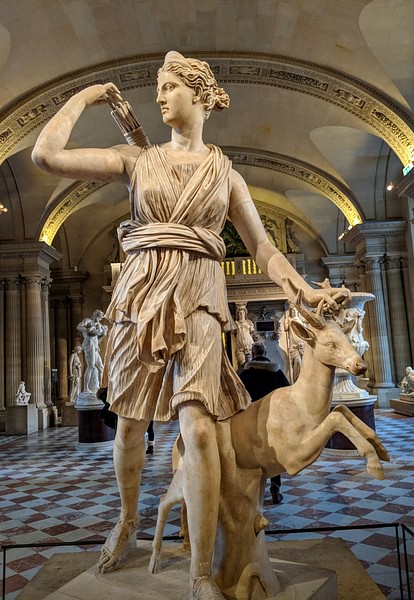
Artemis was the Greek goddess of hunting, wild nature, and chastity. Daughter of Zeus and sister of Apollo, Artemis was a patron of girls and young women, and a protectress during childbirth. Artemis was widely worshipped but her most famous cult site was the Temple of Artemis at Ephesus, one of the Seven Wonders of the Ancient World.
Family Relations
In Greek mythology, Artemis is the daughter of Zeus and Leto. Born either on Delos or Ortygia (near Ephesus in Western Turkey), she is the twin sister of the god Apollo. When she was three years old her father sat her on his lap and asked her what gifts she would like. Knowing her father's power, the young Artemis was not shy of asking and this was her reply (one gets the impression she had been thinking about this for a while):
Pray give me eternal virginity; as many names as my brother Apollo; a bow and arrow like his; the office of bringing light; a saffron hunting tunic with a red hem reaching to my knees; sixty young ocean nymphs, all of the same age, as my maids of honour; twenty river nymphs from Amnisus in Crete, to take care of my buskins [boots] and feed my hounds when I am not out shooting; all the mountains in the world; and, lastly, any city you care to choose for me, but one will be enough, because I intend to live on mountains most of the time.
(From Callimachus' Hymn to Artemis, quoted in Graves, 83)
Skills & Associations
Given such gifts as a silver bow made by the Cyclopes and a pack of dogs as a hunting companion from Pan, Artemis was, then, regarded as a patron goddess of hunting and wild nature and a mistress of the animals. For this reason, she is associated with wild animals like the deer and boar (especially young ones), forests, and the moon. As a goddess of chastity, childbirth, and fertility, Artemis Kourotrophos was the patron of young women, particularly brides-to-be, who dedicated their toys to her as symbolic of the transition to full adulthood and the assumption of a wife's responsibilities. Finally, the goddess, as a dweller of wild nature, was linked to boundaries and transition, both in physical terms and the abstract. For this reason, perhaps, the temples dedicated to Artemis were often built either on the margins of human settlements or at places where the land changes such as marshes or at water junctions.
Artemis In Greek Mythology
Artemis plays only a minor role in the Trojan War of Homer's Iliad and is described most often as 'the archer goddess' but also on occasion as the 'goddess of the loud hunt' and 'of the wild, mistress of wild creatures'. Supporting the Trojans, she notably heals Aeneas after he is wounded by Diomedes. Hesiod in his Theogony most often describes her as 'arrow-shooting Artemis.'
A notable episode at the start of the Trojan War which involves the goddess is the saving of Iphigenia, daughter of Agamemnon. The king had displeased the goddess by killing one of her deer in a sacred grove. As punishment, Artemis becalmed the Achaean fleet and only the sacrifice of Iphigenia would appease the goddess into granting a fair wind to Troy. Agamemnon duly offered his daughter in sacrifice, but in pity and at the last moment, the goddess substituted a deer for the girl and made Iphigenia a priestess at her sanctuary at Tauris.
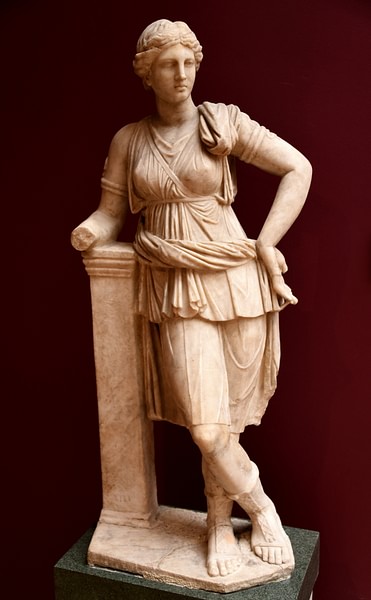
Other accounts of Artemis, however, display her in a far less charitable light. She is said to have killed the hunter Orion after his attempted rape of either Artemis herself or one of her followers. Artemis turned Callisto, one of the goddess' entourage, into a bear after she had lain with Zeus, who then turned her and her son Arcas into the constellations the great and little bear (though not before Arcas had founded the race of Arcadians). The goddess uses her bow to mercilessly kill the six (or in some accounts seven) daughters of Niobe following her boast that her childbearing capacity was greater than Leto's. The hunter Actaion, after he dared boast he was the greater hunter or, in another version, had spied on Artemis while she had bathed in a forest pool, was turned into a stag by the goddess. Actaion was then torn to pieces by his own pack of 50 hunting dogs. Finally, Artemis sent a huge boar to ravage Kalydon after the city had neglected to sacrifice to the goddess. An all-star hunting party of heroes which included Theseus, Jason, the Dioskouroi, Atalanta, and Meleager was organised to hunt and sacrifice the boar in Artemis' honour. After a lengthy expedition, Atalanta and Meleager do finally succeed in killing the boar.
Temple of Artemis at Ephesus
As a deity of fertility, Artemis Ephesia was particularly revered at Ephesus, near to what many believed was her birthplace, Ortygia. Here, her cult included eastern elements (borrowed from goddesses such as Isis, Cybele, and the “Mistress of the Animals”) and her principal symbols were the bee, date palm, and stag. The famous temple of Artemis at the city (begun c. 550 BCE) was almost twice the size of Athens' Parthenon when it was finally finished after a century of labour; it was regarded as one of the Seven Wonders of the Ancient World. The temple boasted 127 columns, and the architrave blocks above them were so heavy, weighing some 24 tons each, that the Ephesians credited Artemis herself with having helped in the construction. Inside the temple was a giant cult statue of the goddess made of cedar wood. Today all that remains of the temple are its foundations and a rather sad single column which has been erected from composite remains.
Other Places of Worship
Other notable places of worship of Artemis were the sanctuaries at Brauron, Tauris, Magnesia, Perge, and on the island of Delos, where the goddess was born in some myth versions and where she assisted the birth of her brother Apollo. At Brauron, on the east coast of Attica, a temple site and sacred spring was in use from the 8th to 3rd century BCE and hosted rites of passage for young girls and brides-to-be. It is not clear what the rites actually involved but painted pottery vessels used for libations at the site do show young girls running and dancing. In Sardis, Lydia (western Turkey) there was the fourth largest Ionic Greek temple ever built set up in Artemis' honour around 300 BCE and then renovated by the Romans in the 2nd century CE who knew Artemis as Diana. At Sparta and Athens (after the Battle of Marathon of 490 BCE), Artemis was worshipped as Artemis Agrotera and regarded as a goddess of battle, a goat being sacrificed to her before an engagement by the Spartans and an annual 500 offered to the goddess by the Athenians.
How is Artemis Represented in Art?
Artemis is most frequently portrayed in ancient Greek art as a beautiful maiden huntress with quiver and bow or, alternatively, a spear. She is often accompanied by a deer, stag, or a hunting dog, and on occasion, she wears a feline skin. Early representations also emphasise her role as goddess of animals and show her winged with a bird or animal in each hand. For example, on the handles of the celebrated Francois vase (570-565 BCE), she holds a panther and stag in one depiction and lions in another. In later Attic red- and black-figure vases she is also often depicted holding a torch.
A celebrated marble representation of the goddess is on the east frieze of the Parthenon where she is seated between Apollo and Aphrodite with Eros (c. 440 BCE). The goddess is pulling up her robe to better cover herself, perhaps in reference to her reputation for chastity. A later and perhaps today more famous representation is as a huntress impressively grasping the antlers of a stag, a pose captured in marble by a Roman sculptor copying a lost Greek original attributed to Leochares (c. 325 BCE). Known as the Diane de Versailles, it is now on display in the Louvre Museum, Paris.
Artemis continued to interest the Romans, and there is a fine 2nd-century CE marble statue of the goddess with bow at the ready and hunting dog at her feet in the Vatican Museums, Rome. The goddess has a crescent moon on her head, reminding of her long association with that celestial body. Finally, Artemis' association with fertility, which was particularly prevalent at Ephesus, is best seen in a marble figurine from that city which has the goddess covered in what appear to be small eggs and animals. Dating to 125-175 CE, it is now on display in the Archaeological Museum of Selcuk, Turkey.
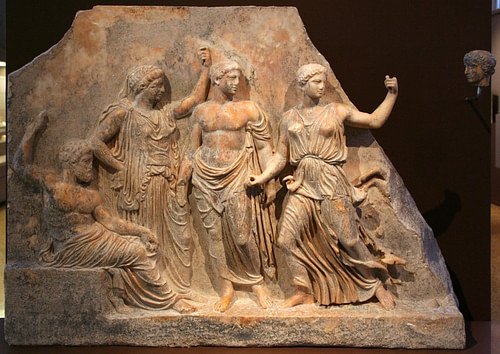
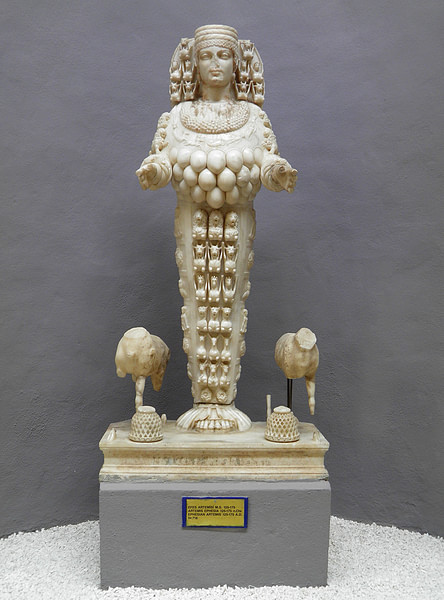
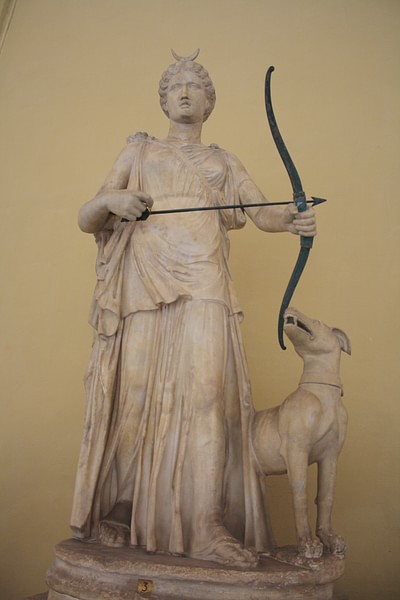
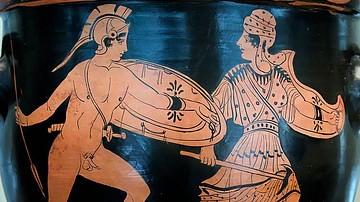
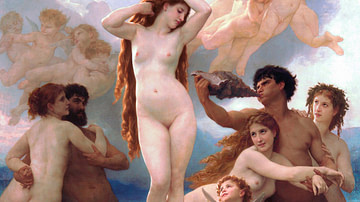
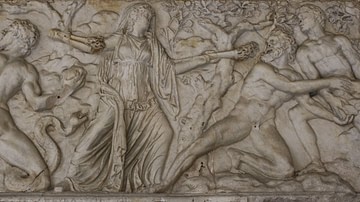
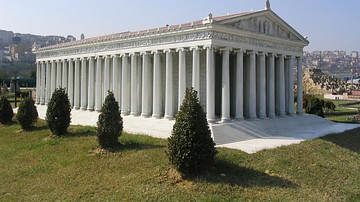
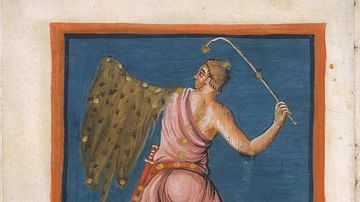
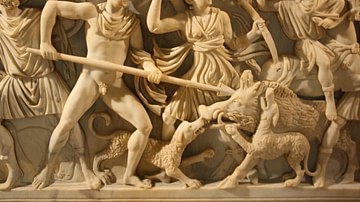

![The Greek Myths: The Complete and Definitive Edition [May 15, 2018] Graves, Robert](https://m.media-amazon.com/images/I/51oRylA0pwL._SL160_.jpg)


